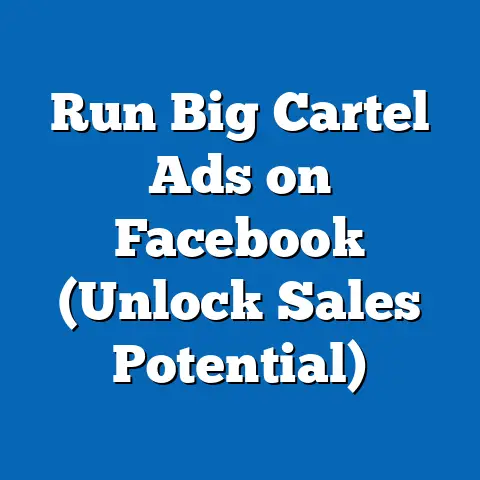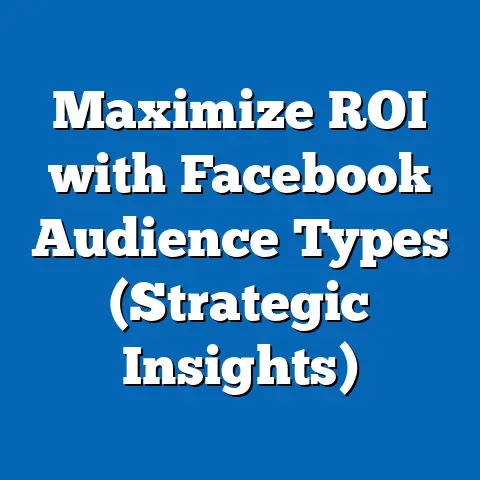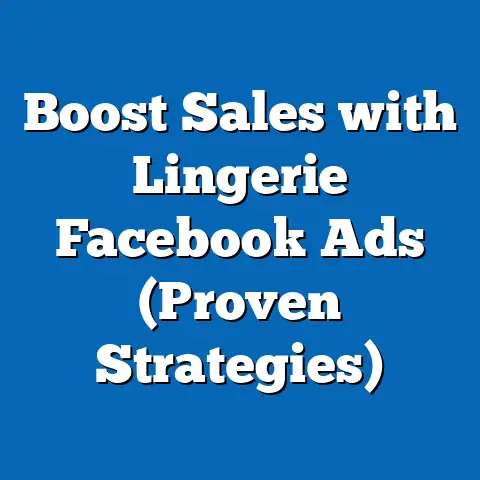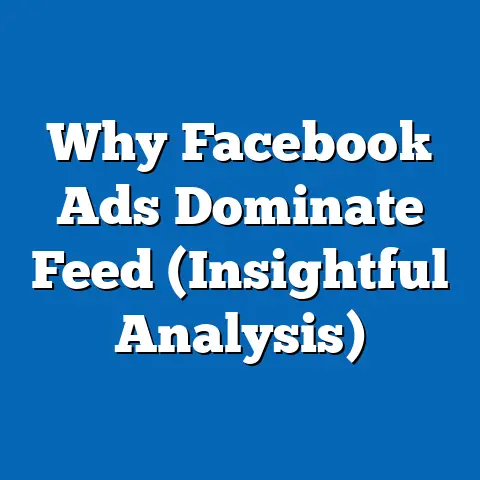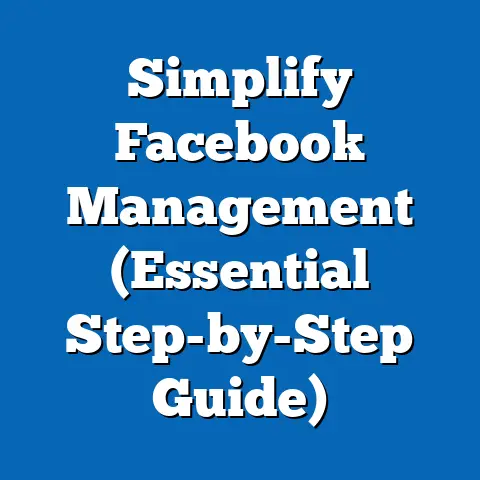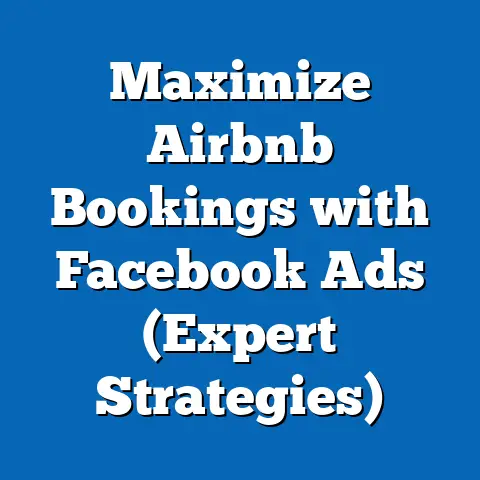Optimize Video for Facebook Ads (Essential Guide)
Video content has completely transformed the advertising landscape, and nowhere is this more evident than on Facebook. As someone who’s spent years crafting and analyzing Facebook ad campaigns, I’ve seen firsthand the incredible power of video to capture attention and drive results. A well-crafted video ad isn’t just an ad; it’s a story, an experience, and a connection with your audience. Unlike static images or text-based ads that can easily get lost in the noise, video ads have the potential to leap off the screen and grab users, compelling them to stop scrolling and engage.
Think about it: how often do you pause when a captivating video pops up in your feed? That’s the magic of video. Studies consistently show that video ads outperform other formats in terms of engagement, click-through rates, and ultimately, conversions. In fact, according to a recent report by HubSpot, 54% of consumers want to see more video content from a brand or business they support. This isn’t just a trend; it’s a fundamental shift in how people consume information and interact with brands online.
But creating effective video ads isn’t just about shooting a pretty video and hoping for the best. It requires a strategic approach, a deep understanding of Facebook’s platform, and a commitment to optimization. That’s where this guide comes in. I’m going to walk you through the essential steps to creating video ads that not only grab attention but also deliver real results for your business. From understanding different ad formats to crafting compelling content and analyzing performance metrics, this guide will equip you with the knowledge and tools you need to succeed in the world of Facebook video advertising. So, let’s dive in and unlock the potential of video to transform your Facebook ad campaigns.
Section 1: Understanding Facebook’s Video Ad Formats
Facebook offers a diverse range of video ad formats, each with its own unique characteristics and ideal use cases. Understanding these formats is crucial for crafting video ads that resonate with your target audience and achieve your specific marketing goals. I’ve found that choosing the right format can significantly impact the performance of your campaign.
Here’s a breakdown of the most popular Facebook video ad formats:
-
In-Feed Video Ads: These ads appear directly in users’ news feeds, blending seamlessly with organic content. They’re perfect for grabbing attention while users are casually browsing. I typically use these to promote brand awareness, drive website traffic, or generate leads.
-
Stories Ads: Short, vertical videos that appear between users’ Stories. Stories ads are highly engaging and offer a more immersive experience. They’re great for showcasing behind-the-scenes content, running contests, or promoting limited-time offers. Given their ephemeral nature, I’ve found that Stories Ads work best with content that feels authentic and in-the-moment.
-
Carousel Ads: These ads allow you to showcase multiple videos (or images) in a single ad unit. Users can swipe through the carousel to view each video. Carousel ads are ideal for showcasing different products, highlighting different features of a single product, or telling a story across multiple videos. I use these for e-commerce clients to showcase their product range.
-
Instant Experience Ads (formerly Canvas Ads): These are full-screen, mobile-optimized experiences that open when a user clicks on your ad. They can include a combination of videos, images, and text. Instant Experience ads are perfect for creating immersive brand experiences and telling compelling stories.
-
Collection Ads: A mobile-first ad format that showcases a catalog of products with a video or image at the top. When users click on the ad, they’re taken to a full-screen Instant Experience where they can browse and purchase products. These are especially useful for e-commerce.
In-Feed Video Ads: These ads appear directly in users’ news feeds, blending seamlessly with organic content. They’re perfect for grabbing attention while users are casually browsing. I typically use these to promote brand awareness, drive website traffic, or generate leads.
Stories Ads: Short, vertical videos that appear between users’ Stories. Stories ads are highly engaging and offer a more immersive experience. They’re great for showcasing behind-the-scenes content, running contests, or promoting limited-time offers. Given their ephemeral nature, I’ve found that Stories Ads work best with content that feels authentic and in-the-moment.
Carousel Ads: These ads allow you to showcase multiple videos (or images) in a single ad unit. Users can swipe through the carousel to view each video. Carousel ads are ideal for showcasing different products, highlighting different features of a single product, or telling a story across multiple videos. I use these for e-commerce clients to showcase their product range.
Instant Experience Ads (formerly Canvas Ads): These are full-screen, mobile-optimized experiences that open when a user clicks on your ad. They can include a combination of videos, images, and text. Instant Experience ads are perfect for creating immersive brand experiences and telling compelling stories.
Collection Ads: A mobile-first ad format that showcases a catalog of products with a video or image at the top. When users click on the ad, they’re taken to a full-screen Instant Experience where they can browse and purchase products. These are especially useful for e-commerce.
When choosing a video ad format, consider the following:
- Your marketing goals: What are you trying to achieve with your ad campaign? Are you looking to increase brand awareness, drive website traffic, generate leads, or make sales?
- Your target audience: Who are you trying to reach with your ad? What are their interests, demographics, and behaviors?
- Your budget: Some ad formats are more expensive than others.
- Mobile Optimization: Given that the vast majority of Facebook users access the platform via mobile, it’s crucial to ensure your videos are optimized for mobile viewing. This includes using vertical or square aspect ratios, clear visuals that are easy to see on smaller screens, and including text overlays or captions to ensure viewers can understand the message even with the sound off.
Aspect Ratios and Lengths:
Facebook recommends the following aspect ratios for video ads:
- Square (1:1): Ideal for in-feed ads and carousel ads.
- Vertical (9:16): Ideal for Stories ads and in-feed ads on mobile.
- Landscape (16:9): Ideal for in-feed ads on desktop.
As for video lengths, shorter is often better. While Facebook allows videos up to 240 minutes long, I’ve found that videos under 15 seconds tend to perform best, especially for Stories ads. For in-feed ads, aim for videos between 15 and 60 seconds. The key is to grab attention quickly and keep viewers engaged throughout the entire video.
Takeaway: Facebook offers a variety of video ad formats to suit different marketing goals and target audiences. By understanding the characteristics of each format and optimizing your videos accordingly, you can significantly improve the performance of your Facebook ad campaigns. Remember to always prioritize mobile optimization and keep your videos concise and engaging.
Section 2: Crafting Compelling Video Content
Creating visually stunning video is just one piece of the puzzle. To truly captivate your audience and drive results, you need compelling content that resonates with them on an emotional level. I’ve seen countless beautifully shot videos fail to deliver because they lacked a clear message or failed to connect with the target audience.
Here are some key elements of engaging video content:
- Scripting: A well-written script is the foundation of any great video. Your script should clearly communicate your message, highlight the benefits of your product or service, and include a strong call to action. I always start with a clear understanding of my target audience and their pain points. What problems are they facing? How can my product or service help them?
- Visuals: Your visuals should be high-quality, engaging, and relevant to your message. Use a mix of live-action footage, animations, and graphics to keep viewers interested. Ensure your visuals are optimized for mobile viewing, with clear text and easy-to-understand graphics.
- Sound: Sound is just as important as visuals. Use clear, professional-quality audio to ensure your message is heard loud and clear. Add music and sound effects to enhance the emotional impact of your video.
- Captivating Opening: You have just a few seconds to grab viewers’ attention. Start your video with a captivating opening that immediately hooks them in. This could be a thought-provoking question, a surprising statistic, or a visually stunning scene. I often use customer testimonials or relatable scenarios to grab attention right away.
- Brand Alignment: Your video content should be consistent with your brand’s overall message and identity. Use your brand colors, fonts, and logo to create a cohesive look and feel. Ensure your video content reflects your brand’s values and personality.
- Subtitles and Text Overlays: Many Facebook users watch videos with the sound off, especially on mobile. Add subtitles and text overlays to ensure your message is understood even without sound. This also makes your videos more accessible to viewers who are deaf or hard of hearing. I’ve found that adding captions can increase view time by as much as 12%.
Aligning Content with Brand Message and Target Audience:
Creating compelling video content starts with a deep understanding of your brand and your target audience. What are your brand’s values, mission, and personality? Who are you trying to reach with your video ads? What are their interests, demographics, and behaviors?
Once you have a clear understanding of your brand and your target audience, you can start crafting video content that resonates with them. Use language, imagery, and music that appeals to your target audience. Highlight the benefits of your product or service in a way that is relevant to their needs and interests.
Example:
Let’s say you’re selling a fitness app. Your video ad could feature real people using your app and achieving their fitness goals. You could use upbeat music and inspiring visuals to create a positive and motivating atmosphere. You could also include testimonials from satisfied customers.
Takeaway: Compelling video content is the key to success with Facebook video ads. By crafting well-written scripts, using high-quality visuals and sound, and aligning your content with your brand message and target audience, you can create videos that grab attention, engage viewers, and drive results. Don’t forget the importance of subtitles and text overlays to ensure your message is understood even without sound.
Section 3: Technical Optimization for Facebook Video Ads
Creating great content is only half the battle. To ensure your video ads perform optimally on Facebook, you need to pay attention to the technical details. I’ve seen many stunning videos suffer from poor performance due to technical issues like low resolution, slow loading times, or incorrect file formats.
Here’s a checklist of technical specifications for Facebook video ads:
- Video Resolution: Aim for the highest resolution possible, ideally 1080p (1920×1080 pixels). This ensures your video looks crisp and clear on all devices.
- File Format: Facebook supports a wide range of video file formats, including MP4, MOV, and AVI. However, MP4 is generally recommended as it offers the best balance of quality and file size.
- File Size: Facebook has a maximum file size limit of 4GB for video ads. However, smaller file sizes are generally better, as they load faster and consume less bandwidth.
- Video Codec: H.264 is the recommended video codec for Facebook video ads.
- Audio Codec: AAC is the recommended audio codec for Facebook video ads.
- Frame Rate: A frame rate of 30 frames per second (fps) is generally recommended for Facebook video ads.
- Bitrate: The bitrate determines the amount of data used to encode your video. A higher bitrate generally results in better quality, but also larger file sizes. Facebook recommends a bitrate of 8 Mbps for 1080p videos.
Compression and Encoding Techniques:
Compression and encoding are essential for optimizing your video ads for Facebook. Compression reduces the file size of your video without significantly impacting quality. Encoding converts your video into a format that is compatible with Facebook’s platform.
Here are some tips for compressing and encoding your video ads:
- Use a professional video editing software: Tools like Adobe Premiere Pro, Final Cut Pro, and DaVinci Resolve offer advanced compression and encoding options.
- Choose the right codec: H.264 is the recommended video codec for Facebook.
- Adjust the bitrate: Experiment with different bitrates to find the sweet spot between quality and file size.
- Use two-pass encoding: Two-pass encoding analyzes your video twice, resulting in better quality compression.
- Remove unnecessary audio tracks: If your video only contains music, remove the voiceover track to reduce file size.
Why These Specifications Matter:
Adhering to these technical specifications is crucial for several reasons:
- Improved User Experience: High-quality videos that load quickly provide a better user experience, leading to increased engagement and view time.
- Increased Reach: Facebook’s algorithm favors videos that are optimized for the platform, giving them greater visibility in users’ news feeds.
- Reduced Costs: Smaller file sizes consume less bandwidth, reducing your advertising costs.
- Avoidance of Rejection: Failing to meet Facebook’s technical specifications can result in your ad being rejected.
Takeaway: Technical optimization is a critical aspect of creating effective Facebook video ads. By adhering to Facebook’s technical specifications, using proper compression and encoding techniques, and prioritizing user experience, you can ensure your videos perform optimally and achieve your marketing goals.
Section 4: Analyzing Performance Metrics
Creating and launching your video ads is just the beginning. To truly optimize your campaigns and maximize your ROI, you need to track and analyze your performance metrics. I’ve found that regularly monitoring key performance indicators (KPIs) is essential for understanding what’s working, what’s not, and where you can make improvements.
Here are some of the most important KPIs to track for Facebook video ads:
- View Rate: The percentage of people who saw your ad and watched at least 3 seconds of it (or 2 seconds for videos under 15 seconds). A higher view rate indicates that your ad is grabbing attention and engaging viewers.
- Engagement Rate: The percentage of people who interacted with your ad (e.g., liked, commented, shared, clicked). A higher engagement rate indicates that your ad is resonating with your target audience.
- Click-Through Rate (CTR): The percentage of people who clicked on your ad. A higher CTR indicates that your ad is compelling and relevant to your target audience.
- Conversion Rate: The percentage of people who took a desired action after clicking on your ad (e.g., made a purchase, filled out a form, downloaded an app). A higher conversion rate indicates that your ad is effectively driving results.
- Cost Per View (CPV): The average cost you pay for each view of your video ad.
- Return on Ad Spend (ROAS): The amount of revenue you generate for every dollar you spend on advertising.
Setting Up A/B Testing:
A/B testing is a powerful tool for optimizing your video ads. It involves creating two or more versions of your ad with slight variations (e.g., different headlines, visuals, or calls to action) and then testing them against each other to see which performs best.
Here are some tips for setting up A/B testing for your video ads:
- Test one variable at a time: This allows you to isolate the impact of each variable on your ad’s performance.
- Use a large enough sample size: This ensures that your results are statistically significant.
- Run your tests for a sufficient amount of time: This allows you to collect enough data to draw meaningful conclusions.
- Use Facebook’s A/B testing tool: Facebook offers a built-in A/B testing tool that makes it easy to create and manage your tests.
Using Facebook Insights and Ads Manager:
Facebook Insights and Ads Manager provide a wealth of data about your video ad performance. Use these tools to track your KPIs, analyze your A/B test results, and identify areas for improvement.
Here are some tips for using Facebook Insights and Ads Manager:
- Customize your dashboards: Focus on the KPIs that are most important to your business goals.
- Use filters and segments: Analyze your data by demographics, interests, and behaviors.
- Create custom reports: Track your progress over time.
- Set up automated alerts: Get notified when your KPIs reach certain thresholds.
Takeaway: Analyzing performance metrics is essential for optimizing your Facebook video ad campaigns. By tracking key KPIs, setting up A/B testing, and using Facebook Insights and Ads Manager, you can gain valuable insights into what’s working and what’s not, allowing you to make data-driven decisions that improve your ROI.
Section 5: Strategies for Effective Video Ad Campaigns
Now that you understand the technical aspects of video optimization and the importance of performance analysis, let’s discuss some strategies for running effective video ad campaigns on Facebook. I’ve learned that a successful campaign requires a holistic approach that combines creative content with strategic targeting and promotion.
Here are some key strategies to consider:
- Targeting Options: Facebook offers a wide range of targeting options, allowing you to reach specific audiences based on demographics, interests, behaviors, and more. Use these targeting options to ensure your video ads are seen by the people who are most likely to be interested in your product or service. Custom Audiences can be a great way to retarget people who have already interacted with your business.
- Audience Segmentation: Segment your audience based on their interests, demographics, and behaviors. This allows you to tailor your video ads to specific groups of people, increasing their relevance and engagement.
- Retargeting Strategies: Retargeting involves showing your video ads to people who have already interacted with your business (e.g., visited your website, watched your videos, or liked your Facebook page). This can be a highly effective way to drive conversions.
- Ad Placement: Choose the right ad placement for your video ads. In-feed ads are great for grabbing attention while users are casually browsing, while Stories ads are more engaging and offer a more immersive experience.
- Timing and Frequency: Consider the timing and frequency of your ad placement. Show your ads when your target audience is most likely to be online and engaged. Avoid showing your ads too frequently, as this can lead to ad fatigue.
Best Practices for Promoting Video Ads:
- Use a clear call to action: Tell viewers what you want them to do after watching your video (e.g., visit your website, make a purchase, download an app).
- Offer a compelling incentive: Give viewers a reason to take action (e.g., a discount, a free trial, a bonus offer).
- Use high-quality visuals and sound: Ensure your video ads are visually appealing and sound professional.
- Keep your videos concise and engaging: Grab viewers’ attention quickly and keep them engaged throughout the entire video.
- Test different versions of your ads: Use A/B testing to optimize your ads for maximum performance.
Takeaway: Running effective video ad campaigns on Facebook requires a strategic approach that combines creative content with strategic targeting and promotion. By using Facebook’s targeting options, segmenting your audience, implementing retargeting strategies, and following best practices for promoting video ads, you can maximize your ROI and achieve your marketing goals.
Conclusion: The Future of Video Advertising on Facebook
Video advertising on Facebook is a dynamic and constantly evolving landscape. As technology advances and user behavior shifts, it’s crucial to stay updated with the latest trends and best practices. I believe that video will continue to play an increasingly important role in the future of digital marketing, particularly on social media platforms like Facebook.
Here are some key trends to watch out for:
- Short-Form Video: Short-form video content, such as TikTok videos and Instagram Reels, is becoming increasingly popular. Expect to see more short-form video ads on Facebook.
- Interactive Video: Interactive video ads allow viewers to engage with the ad in a more meaningful way (e.g., by answering questions, taking polls, or playing games). This can lead to increased engagement and brand recall.
- Augmented Reality (AR): AR technology allows viewers to overlay digital content onto the real world. This can be used to create immersive and engaging video ad experiences.
- Personalized Video: Personalized video ads are tailored to individual viewers based on their interests, demographics, and behaviors. This can lead to increased relevance and engagement.
To remain competitive in the ever-changing digital marketplace, it’s essential to:
- Stay updated with the latest trends and best practices.
- Experiment with new video ad formats and strategies.
- Continuously track and analyze your performance metrics.
- Adapt your campaigns to changing user behavior.
By embracing innovation and staying ahead of the curve, you can unlock the full potential of video advertising on Facebook and drive real results for your business. Remember, the key to success is to create compelling content that resonates with your target audience and delivers a clear message. Good luck, and happy advertising!

